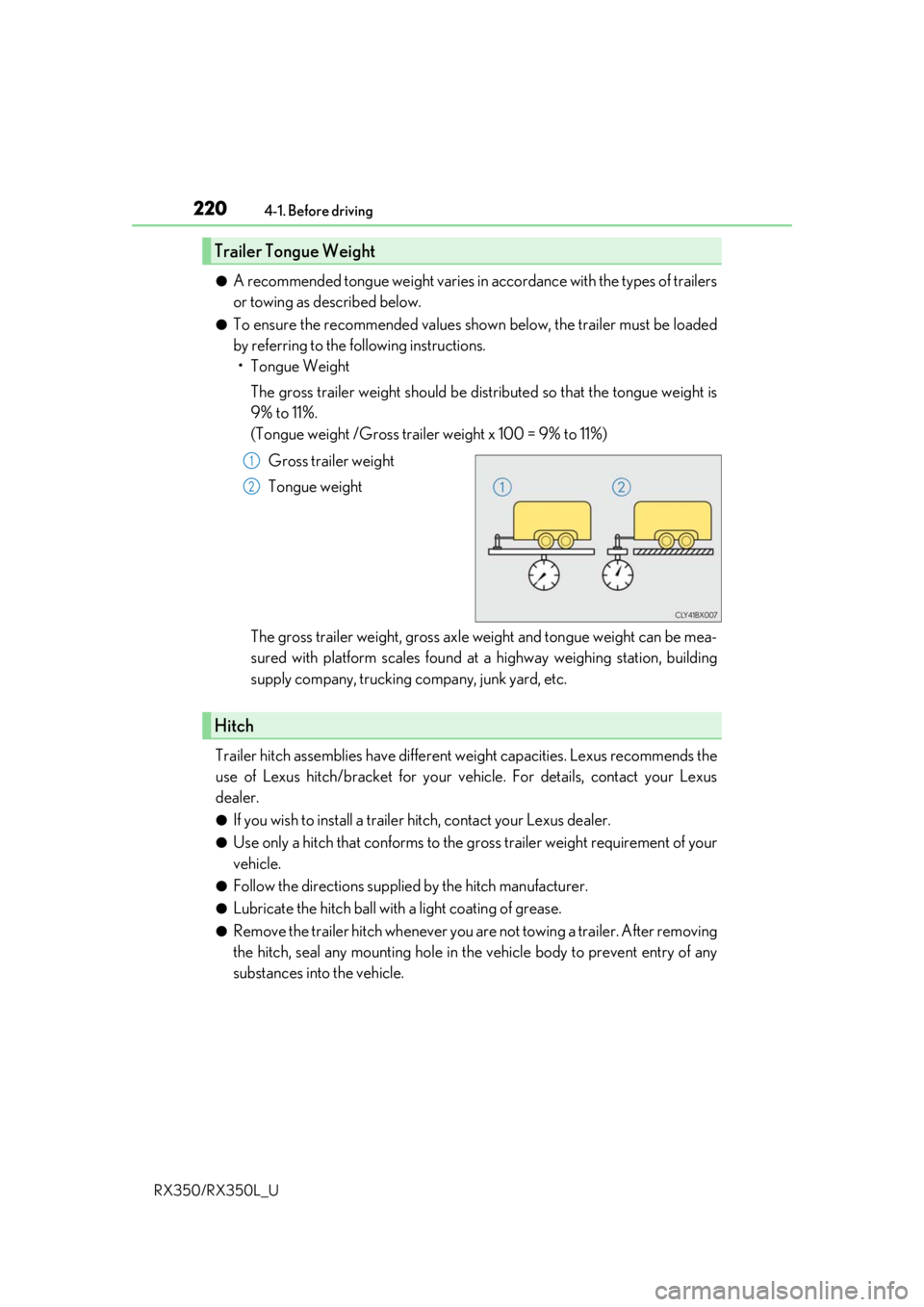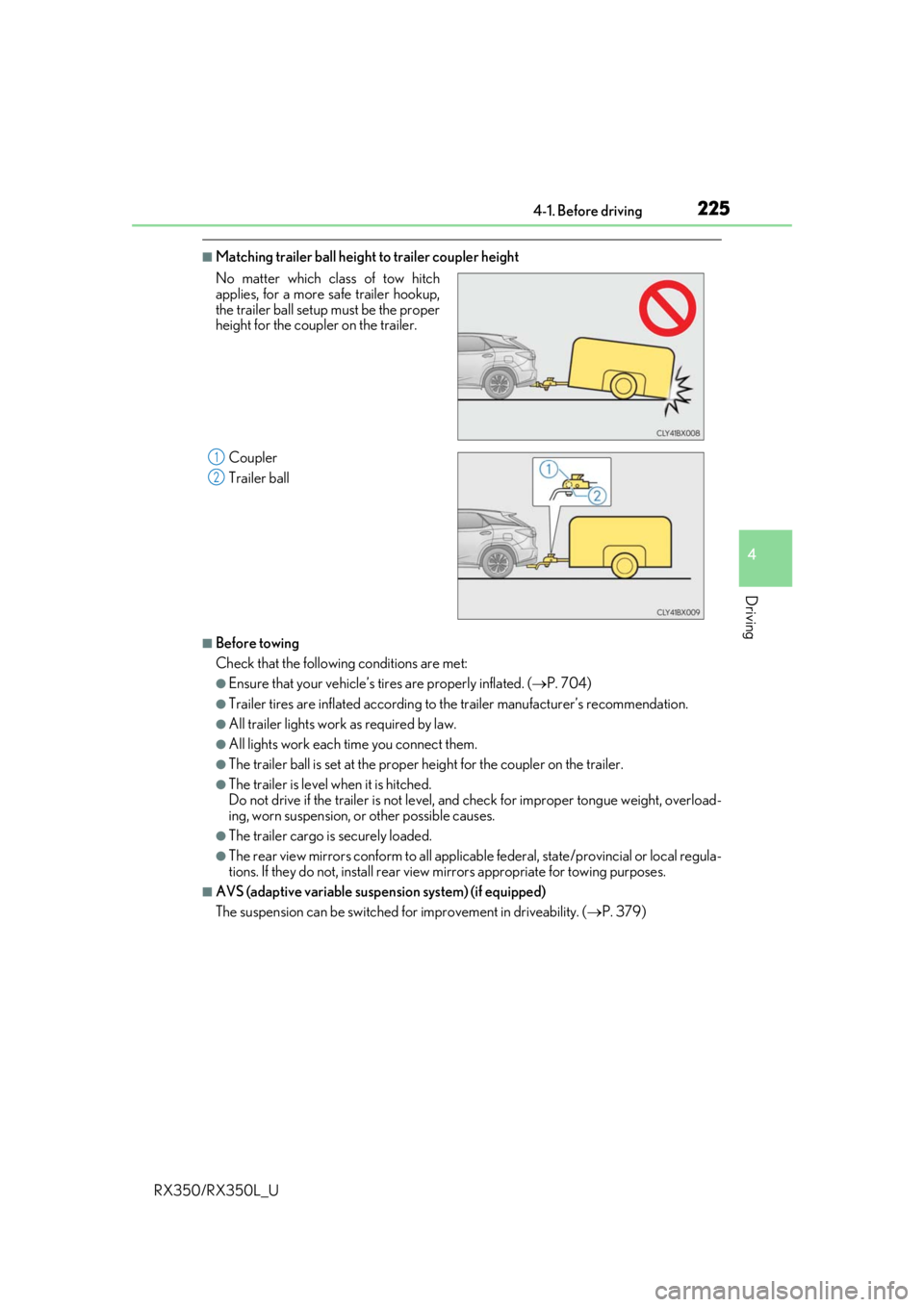Page 217 of 777
2164-1. Before driving
RX350/RX350L_U
■GCWR (Gross Combination Weight Rating)
The maximum allowable gross com-
bination weight. The gross combina-
tion weight is the sum of the total
vehicle weight (including the occu-
pants, cargo and any optional equip-
ment installed on the vehicle) and
the weight of the trailer being towed
(including the cargo in the trailer).
■GVWR (Gross Vehicle Weight Rating)
The maximum allowable gross vehi-
cle weight. The gross vehicle weight
is the total weight of the vehicle.
When towing a trailer, it is the sum of
the vehicle weight (including the
occupants, cargo and any optional
equipment installed on the vehicle)
and the tongue weight.
■GAWR (Gross Axle Weight Rating)
The maximum allowable gross axle
weight. The gross axle weight is the
load placed on each axle (front and
rear).
Towing related terms
Front GAWR
Rear GAWR
Page 218 of 777
2174-1. Before driving
4
Driving
RX350/RX350L_U
■TWR (Trailer Weight Rating)
The maximum allowable gross trailer
weight. The gross trailer weight is
the sum of the trailer weight and the
weight of the cargo in the trailer.
TWR is calculated assuming base
vehicle with one driver, one front
passenger, towing package (if avail-
able), hitch and hitch systems (if
required).
Additional optional equipment, passengers and cargo in the vehicle will reduce the
trailer weight rating so as not to exceed GCWR, GVWR and GAWR.
If the gross trailer weight exceeds 3000 lb. (1360 kg), it is recommended to use a
trailer with 2 or more axles.
■Unbraked TWR (Unbraked Trailer Weight Rating)
The trailer weight rating for towing a
trailer without a trailer service brake
system.
■Tongue Weight
The load placed on the trailer hitch
ball. ( P. 220)
(With brakes)
(Without brakes)
Page 219 of 777
2184-1. Before driving
RX350/RX350L_U
●The gross trailer weight must ne ver exceed 3500 lb. (1585 kg).
●The gross combination weight mu st never exceed the following:
RX350
2WD models: 9165 lb. (4157 kg)
AWD models: 9360 lb. (4246 kg)
RX350L
2WD models: 9205 lb. (4175 kg)
AWD models: 9360 lb. (4246 kg)
●The gross vehicle weight must never
exceed the GVWR indicated on the
Certification Label.
●The gross axle weight on each axle
must never exceed the GAWR indi-
cated on the Certification Label.
●If the gross trailer weight is over the unbraked TWR, trailer service brakes are
required.
●If the gross trailer weight is over 2000 lb. (907 kg), a sway control device with
sufficient capacity is required.
Weight limits
Page 220 of 777
2194-1. Before driving
4
Driving
RX350/RX350L_U
Confirm that the gross trailer weight, gross combination weight, gross vehicle
weight, gross axle weight and tongue weight are all within the limits.
■GCWR*
RX350
2WD models: 9165 lb. (4157 kg)
AWD models: 9360 lb. (4246 kg)
RX350L
2WD models: 9205 lb. (4175 kg)
AWD models: 9360 lb. (4246 kg)
■TWR*
3500 lb. (1585 kg)
■Unbraked TWR*
1000 lb. (450 kg)
*: These models meet the tow-vehicle trailering requirement of SAE International per
SAE J2807.
GCWR, TWR and Unbraked TWR
Page 221 of 777

2204-1. Before driving
RX350/RX350L_U
●A recommended tongue weight varies in accordance with the types of trailers
or towing as described below.
●To ensure the recommended values show n below, the trailer must be loaded
by referring to the following instructions. • Tongue Weight
The gross trailer weight should be dist ributed so that the tongue weight is
9% to 11%.
(Tongue weight /Gross trailer weight x 100 = 9% to 11%)
Gross trailer weight
Tongue weight
The gross trailer weight, gross axle weight and tongue weight can be mea-
sured with platform scales found at a highway weighing station, building
supply company, trucking company, junk yard, etc.
Trailer hitch assemblies have different weight capacities. Lexus recommends the
use of Lexus hitch/bracket for your ve hicle. For details, contact your Lexus
dealer.
●If you wish to install a trailer hitch, contact your Lexus dealer.
●Use only a hitch that conforms to the gross trailer weight requirement of your
vehicle.
●Follow the directions supplied by the hitch manufacturer.
●Lubricate the hitch ball with a light coating of grease.
●Remove the trailer hitch whenever you ar e not towing a trailer. After removing
the hitch, seal any mounting hole in the vehicle body to prevent entry of any
substances into the vehicle.
Trailer Tongue Weight
1
2
Hitch
Page 222 of 777
2214-1. Before driving
4
Driving
RX350/RX350L_U
Use the correct trailer ball for your application.Trailer ball load rating
Matches or exceeds the gross trailer
weight rating of the trailer.
Ball diameter
Matches the size of the trailer coupler.
Most couplers are stamped with the
required trailer ball size.
Shank length
Protrudes beyond the bottom of the lock washer and nut by at least 2 threads.
Shank diameter
Matches the ball mount hole diameter size.
RX350
Weight carrying ball position:
44.96 in. (1142 mm)
Hitch receiver pin hole position:
35.94 in. (913 mm)
RX350L
Weight carrying ball position:
49.72 in. (1263 mm)
Hitch receiver pin hole position:
45.08 in. (1145 mm)
Selecting trailer ball
1
2
Trailer classTypical trailer ball size
IV2 5/16 in.
II and III2 in.
I1 7/8 in.
Positions for towing hitch receiver and hitch ball
3
4
1
2
1
2
Page 226 of 777

2254-1. Before driving
4
Driving
RX350/RX350L_U
■Matching trailer ball height to trailer coupler height
■Before towing
Check that the following conditions are met:
●Ensure that your vehicle’s tires are properly inflated. ( P. 704)
●Trailer tires are inflated according to the trailer manufacturer’s recommendation.
●All trailer lights work as required by law.
●All lights work each time you connect them.
●The trailer ball is set at the proper height for the coupler on the trailer.
●The trailer is level when it is hitched.
Do not drive if the trailer is not level, and check for improper to ngue weight, overload-
ing, worn suspension, or other possible causes.
●The trailer cargo is securely loaded.
●The rear view mirrors conform to all applicable federal, state/provincial or local regula-
tions. If they do not, install rear view mirrors appropriate for towing purposes.
■AVS (adaptive variable suspension system) (if equipped)
The suspension can be switched fo r improvement in driveability. (P. 379)
No matter which class of tow hitch
applies, for a more safe trailer hookup,
the trailer ball setup
must be the proper
height for the coupler on the trailer.
Coupler
Trailer ball
1
2
Page 227 of 777

2264-1. Before driving
RX350/RX350L_U
■Break-in schedule
If your vehicle is new or equipped with any new power train components (such as an
engine, transaxle, transfer (AWD models), rear differential (AWD models) or wheel
bearing), Lexus recommends that you do not tow a trailer until the vehicle has been
driven for over 500 miles (800 km).
After the vehicle has been driven for over 500 miles (800 km), you can start towing.
However, for the next 500 miles (800 km), drive the vehicle at a speed of less than
50 mph (80 km/h) when towing a trailer, and avoid full throttle acceleration.
■Maintenance
●If you tow a trailer, your vehicle will require more frequent maintenance due to the addi-
tional load. (See “Warranty and Services Guide”, “Owner’s Manual Supplement” or
“Scheduled Maintenance”.)
●Retighten the fixing bolts of the towing ba ll and bracket after approximately 600 miles
(1000 km) of trailer towing.
■If trailer sway occurs
One or more factors (crosswinds, passing ve hicles, rough roads, etc.) can adversely
affect handling of your vehicle and trailer, causing instability.
●If trailer swaying occurs:
• Firmly grip the steering wh eel. Steer straight ahead.
Do not try to control trailer sway ing by turning the steering wheel.
• Begin releasing the accelerator pedal im mediately but very gradually to reduce
speed.
Do not increase speed. Do not apply vehicle brakes.
If you make no extreme correction with the st eering or brakes, your vehicle and trailer
should stabilize. (if enabled, Trailer Sway Control can also he lp to stabilize the vehicle and
trailer.)
●After the trailer sw aying has stopped:
• Stop in a safe place. Get all occupants out of the vehicle.
• Check the tires of the vehicle and the trailer.
• Check the load in the trailer. Make sure the load has not shifted.
Make sure the tongue weight is appropriate, if possible.
• Check the load in the vehicle.
Make sure the vehicle is not ov erloaded after occupants get in.
If you cannot find any problems, the speed at which trailer swaying occurred is beyond
the limit of your particular vehicle-trailer combination.
Drive at a lower speed to prevent instability. Remember that swaying of the towing vehi-
cle-trailer increases as speed increases.